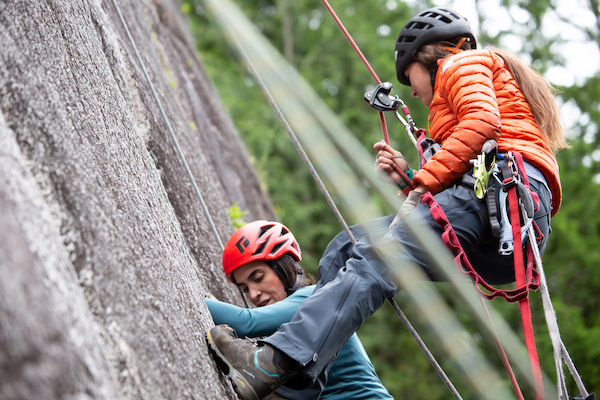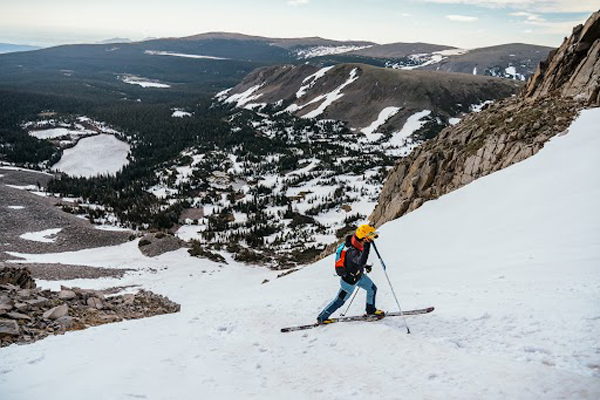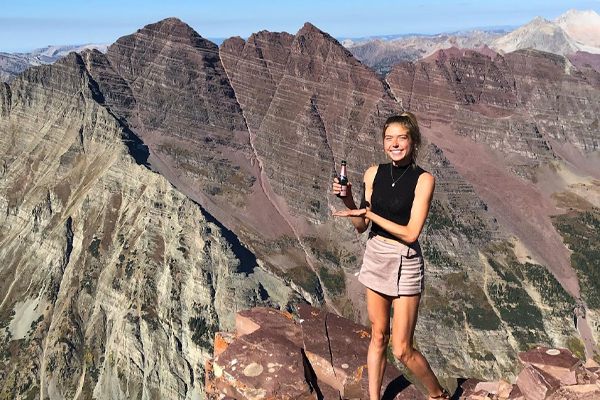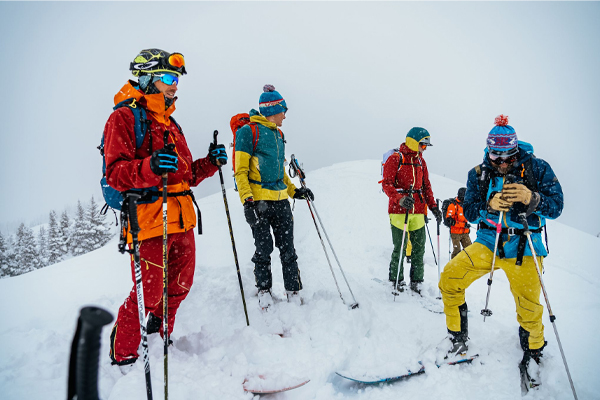Anton Krupicka - Sellaronda Pt. 2
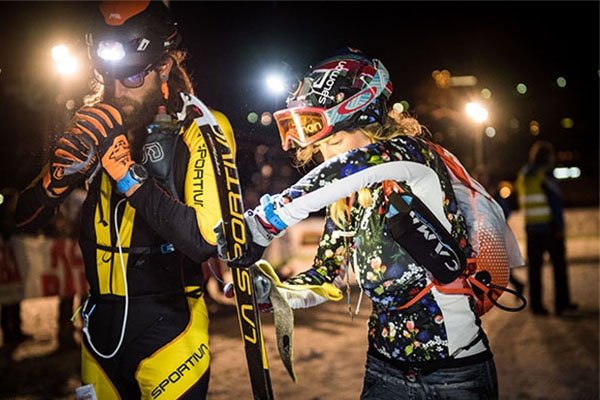
That night, "all I could think was—what a crazy life experience. I’m barely a skier. Yet there I was...
- - -
The starting line atmosphere for the Sellaronda Ski Marathon was very reminiscent of any of the iconic European Mountain Running ultras I’ve done—UTMB in the Alps, Lavaredo Ultra Trail in the Dolomites, Transgrancanaria in the Canary Islands, the Pyrenean Cavalls del Vent. Evening send-off, frenetic MC on the loudspeaker, dramatic music blaring, a thousand-plus athletes crammed into the square of a quaint mountain village along with probably twice or thrice as many spectators—it’s a scene we don’t really get for human-powered mountain sports here in the States. Milling about Canazei in the still-warm evening air in basically a superhero suit, Dolomiti giants towering above the narrow corridors of town, all I could think was, “dang, what a crazy life experience. I’m barely a skier.” Yet there I was. Lucky, grateful.
Wrangling a Sea of Spandex
The paraphernalia of skiing—the skis and poles themselves—add a complicating element to orchestrating a skimo race start of this magnitude. The race organization had trucked in a few blocks’ worth of snow to cover the cobblestones so that racers could seamlessly transition from starting gun to on-piste action—I can only imagine the madness that would ensue if everyone were forced into a running-to-skiing transition on the edge of town such as we had at this year’s Tellurando skimo race in Telluride, CO. No problems there, but that race had approximately 20 teams, not 650.
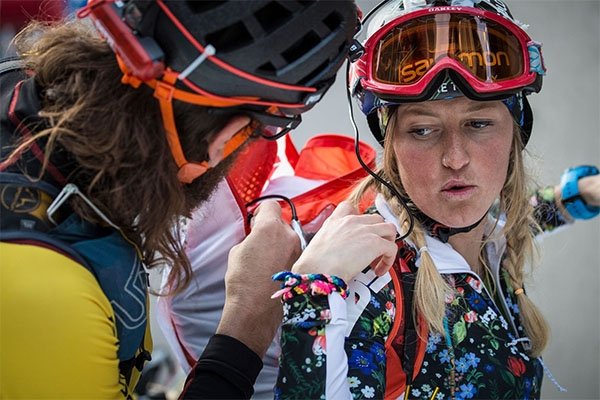
Last minute gear adjustments at the start.
The inherent awkwardness of skis and poles, however, required being sent off in waves of 100 teams or so, and assembling those waves of athletes long before the race start. So, instead of a typical warm-up of skinning a few hundred feet of vertical and getting the body going, teams staked out their spots on the start line by placing their skis and poles on the ground (laying the skis on either edges or bindings, mind you, as the evening’s warm temps and wet snow would’ve meant soaked skins that would’ve soon iced up upon climbing rapidly into cooler temperatures—it’s always the little things in this sport!) and then running ski-booted micro-laps in the perhaps 30 yards of space between assembled waves. Pretty funny.
Due to this improvised warm-up, Martina and I got out our skins for a preparatory sticking and unsticking on the skis so that the initial skin-rip transition at the top of the first climb wouldn’t be compromised by too much glue stickiness. When I pulled out my pair of skins—traditional width for the first two somewhat steeper climbs—Martina was aghast at their length.
“What?! Too long! No! You will never get enough glide! Here, you have to use my back-up skins.”
Poor Martina, she couldn’t trust this neophyte Yankee to get anything right on his own. Chastened, I handed my over-long skins to a friend and tucked her extra pair into the front of my suit. Lesson learned.
Warding off A Case of Chronic Casualitis
That afternoon as we were killing time in the hotel, getting kitted up and waiting for the race start, I asked Martina if she was excited or nervous. I don’t remember her answer, but I do remember my comment that I hadn’t been nervous for a race in more than 10 years. Which is true. I don’t think I’ve been nervous for a race since running track in college.
For me, a lack of nerves before a race has one of two provenances, depending on the race. In mountain ultras, I’ve just always been confident. Admittedly, perhaps, sometimes even overconfident. I told Martina the last time I can remember not sleeping well the night before a race was before my very first ultra, the 2006 Leadville 100. But, I qualified, that was because I had been sleeping peacefully on the floor of a public restroom while it rained gently outside, when my crew and pacers rolled in, drunk, at midnight, before a 2:45am wake-up (Leadville starts at 4am). I would’ve slept just fine otherwise.
I asked Martina if she was excited or nervous. I don’t remember her answer, but I do remember my comment that I hadn’t been nervous for a race in more than 10 years. Which is true.
In non-ultras (i.e., races in which I basically don’t have a chance) the lack of nerves was a by-product of general nonchalance, bordering on insouciance. Short races, road races, bike races, skimo races, Flatiron races…I just didn’t take any of it very seriously. Once the gun went off, I always tried really, really hard, but I didn’t waste any physical or emotional energy getting worked up about it beforehand. My friend Buzz refers to this as Casualitis, something that he sheepishly cops to himself.
The only problem with that in skimo is that: 1) it’s a highly technical sport that requires a lot of focus, and 2) I don’t have enough skill or experience-base to perform those technical aspects by relying on muscle-memory alone. (Unlike, say, the technical aspects of Flatiron speed-scrambling. I’ve logged literally thousands upon thousands of pitches of scrambling over the years, so the skills required there—while still mandating obvious focus—are like second-nature for me.)
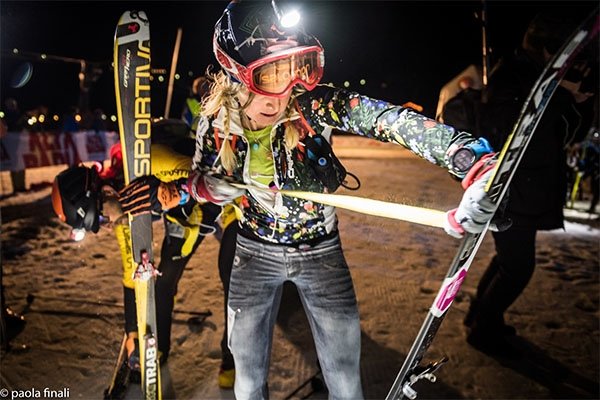
Teamwork at Transitions.
As a result, in almost every skimo race I’ve done, I’ve flubbed the technical side of things: off-piste skinning, transitions, etc. Basically, I haven’t risen to the occasion. The value of having a partner as motivated and experienced as Martina is that I was forced to elevate this aspect of my game.
I’d experienced a similar shift a couple of weeks prior when I partnered up with my buddy Jason Killgore for the Aspen Power of Four skimo race. Jason is an all-around far better skimo athlete than me—his transitions are super dialed and his downhill skills are incomparably superior to my own. Occasionally, (rarely) on the right terrain, and most likely late in a long effort, I’ll sometimes be able to eek out a small advantage over him on an uphill. However, when we partnered up for Po4, I knew I needed to bring it, and couldn’t default to my usual rookie junkshow, so I did. Sure, I was still an order of magnitude slower on the downhills, but I didn’t hemorrhage my usual time at transitions.
Partnering with Martina effected a similar shift in my mindset: I was determined to stay on point. As we left our hotel and walked to the start, I finally made that shift.
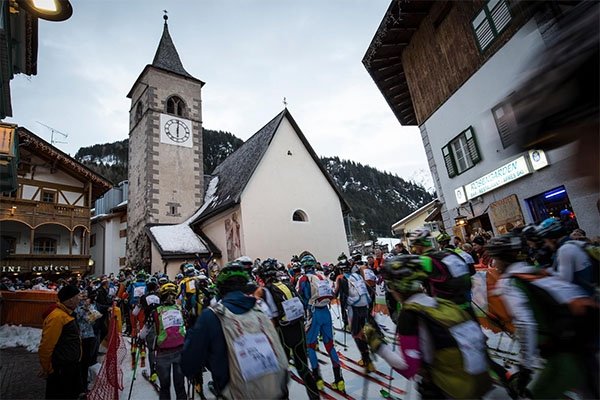
The race start in the center of the mountain village of Canazei.
A Giant Game of Pick-Up Sticks
The first challenge would be the start itself. It’s mayhem. Once the gun went off it was a horror scene of planks and poles. A giant game of Pick-Up Sticks injected with 1300 madly wriggling spandexed bags of flesh. Less than 100 yards in some poor soul went down right in front of me with a blown skin or broken pole, but I somehow didn’t get caught up in his catastrophe and didn’t dare shoot a glance back to observe the inevitable effects of the stampede. After a couple of minutes, though, the surging pack calmed down and everyone settled from running into actual skinning.
I’d kept an eye on Martina a few yards in front of me the whole time and I soon caught up, reveling in the noticeably oxygen-rich air. Canazei sits at an altitude of ~4500’, and no pass in the race was higher than 7500’. I don’t think there’s a skimo race in Colorado that starts below 9000’, and the previous two weekends I’d done races that spent considerable time between 11,000 and 13,000’.
Getting to operate at less than my max on the uphills allowed me to truly enjoy the ambiance. Spectators lined the course; the weather was perfect, if a bit warm. On one steeper section I inadvertently gapped Martina (on steep skinning, I find momentum to be super key in maintaining mohair grip), and this would be our only area of real mismatch for the race—I was stronger on steeper uphills. (Oh, and she was way stronger at skating. And downhill-to-uphill transitions. Okay, never mind.)
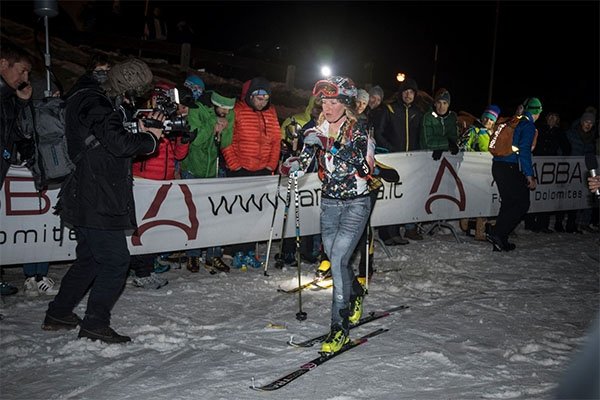
Martina leaving an uphill transition before I'm even attempting to clip in my second boot. Typical.
After we’d rejoined I unwound the 3mm bungee cord from around my waist and Martina clipped in. Before the race, Martina had made it clear that she wasn’t a fan of mixed teams where the man just dragged the woman around the course, but I knew Martina was competitive and there was a women’s team just ahead of us. She didn’t protest, and I was psyched to feel like I was actually contributing something to the effort. And I would get to work hard, too; towing is arduous.
We reached the top of Passo Sella just as headlamps were getting appropriate, and as would be our tactic all night, a short bit before the top Martina unclipped and I ran ahead so that I could execute my inevitably slower transition. I must have run too far ahead, or actually performed a good transition, because when I stood up from ripping my skins Martina wasn’t there yet. Even so, in my adrenalin-induced haste, I tore away from the transition area. I knew from our recce that the first bit of this descent involved a good chunk of skating, so I was sure Martina would catch me before it was time to tuck. Unfortunately, she didn’t, but only a few seconds later she came into view and we were soon ripping down the hill to Selva Gardena.
Selva Gardena to Passo Campolongo
Although “ripping” isn’t an entirely accurate characterization because the downhills at Sellaronda aren’t real rippers. They’re mostly just not steep enough. In fact, the biggest challenge is holding a turnless tuck for that long without your quads giving out. The wax jobs on our skis had clearly been effective as we pinned the downhill well, passing a couple of teams, and a few minutes later we were transitioning, running a few hundred yards through the streets of Gardena (not as bad in ski boots as you might think) to get to the next uphill. So much silly fun!
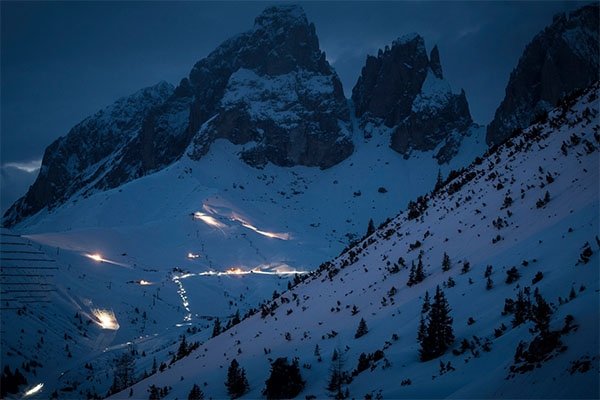
The field climbing to Passo Sella, the first summit of the race.
This uphill to Passo Gardena, was, of course, when the real racing started. Playing to my strengths, it was also the most consistently steep of the whole race. When we’d settled in and the first place women’s team started edging by, Martina clipped back in and it was a steady march to the summit. She was feeling good and pushing hard.
We nailed this transition again and it was another long, gradual downhill into the half-way village of Corvara. The end of this descent consisted of a long section of skating, and though I felt I wasn’t doing too badly, Martina’s far superior technique quickly gapped me here. I came into the transition a few seconds after her—and nontrivially pooped from all the skating—so Martina expedited the process by helping me apply our strategic super-skinny skins while I stuck on the skin for my other ski. To further slow us down I just couldn’t get my right boot to click in to my binding. Not on the first try, okay, but not on the second or third try either. Afterwards, Martina would note, this transition is where we lost the race with the first place women’s team, who would ultimately finish three minutes ahead of us (and 14 minutes under the previous women’s course record, which must be noted). Room for improvement.
Nevertheless, after what felt like an eternity (but was probably more like 90 seconds), we were finally off, charging up the gradual slope, getting maximum glide. This was the long, gradual uphill with the two skins-on downhills, and Martina was in her element, kicking and gliding, and we charged past several teams in front of us. Maybe they just hadn’t paid the same amount of attention to skin strategy. I eventually felt like I got the hang of gliding on the exposed inside edges of my skis, but on the final downhill I was just psyched to have not fallen over. And that the climb finished with an extended steep section that would let me rest (relative to Martina’s pace on the flats).
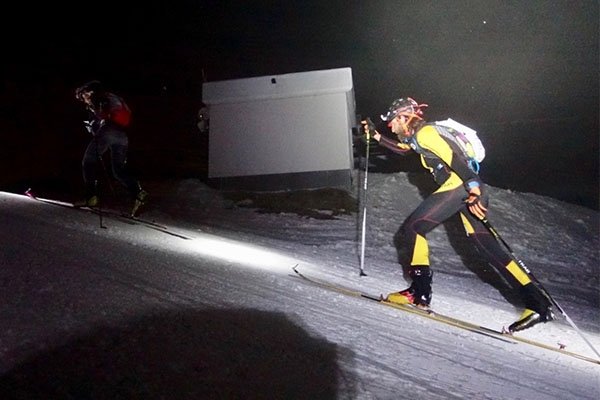
Following Martina on the final uphill.
Smelling the Barn
The weather was forecasted to shift over the course of the race, and that was noticeable up here at Passo Campolongo, where there was a heavy fog. Martina called this a “3min downhill”, and it was indeed short and steeper than the first two. I was feeling my oats, letting the pace run out at the bottom, ahead of Martina, when BAM, the course funneled down into a quick speed-reducing, fencing-enforced zig-zag. Well, I wasn’t quite ready for it, and just about threaded the needle, but not quite and dealt one of the gates a hard but glancing blow with my left ski, sending me into a crash. I recovered quickly enough that Martina didn’t have enough time to catch up to see it happen (or maybe she kindly played dumb), but I’m pretty sure I lost one of my water flasks here.
At the final bottom-of-the-hill transition in Arabba I again flubbed my right toe click-in, but not as badly as before, and we were soon steaming up the last climb to Passo Pordoi, smelling the barn. After a few hundred yards we tried towing, I was still feeling great but my skins were slipping a bit on the icy track and Martina was feeling strong anyhow and we were in first place (or so we were being told) so we didn’t worry. It started snowing at the top of this climb, but we flew through the last downhill, having a blast. This long descent back into Canazei has one soul-crushing herringbone climb and a bunch of big turns that actually require more than just a tuck.
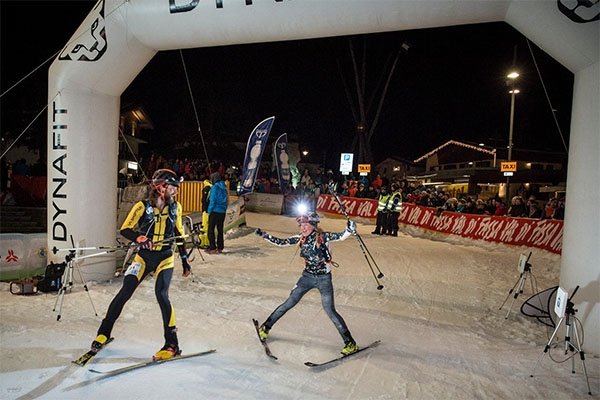
Finish-line exuberance!
Finally, Martina and I crossed the line together, greeted as victors of the Mixed division. Later that evening at the awards ceremony (that ran until 1:30am!), we would learn that we had actually been second by two minutes to a team that had started in the second wave. This dampened our spirits for about three seconds. Ultimately, it was the perfect introduction to the fervor of Euro skimo racing, and leaves me already excited for next year!
Preview & Photos 1-2: © Paolo Finali
Photos 3-7: © Provided by Alta Badia
- - -
ABOUT THE AUTHOR
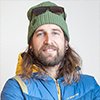 ANTON KRUPICKA is a member of the La Sportiva Mountain Running® Team.
ANTON KRUPICKA is a member of the La Sportiva Mountain Running® Team.
- - -





